Trident II D-5 Fleet Ballistic Missile
| Features |
| Background |
| Recent Developments |
| Specifications |
| Images |
| Sources and Resources |
Overview
Trident II D-5 is the sixth generation member of the U.S. Navy's Fleet Ballistic Missile (FBM) program which started in 1956. Systems have included the Polaris (A1), Polaris (A2), Polaris (A3), Poseidon (C3), and Trident I (C4). The first deployment of Trident II was in 1990 on the USS Tenessee (SSBN 734). While Trident I was designed to the same dimensions as the Poseidon missile it replaced, Trident II is a little larger.
The Trident II D-5 is a three-stage, solid propellant, inertially guided FBM with a range of more than 4,000 nautical miles (4,600 statute miles or 7,360 km) Trident II is more sophisticated with a significantly greater payload capability. All three stages of the Trident II are made of lighter, stronger, stiffer graphite epoxy, whose integrated structure mean considerable weight savings. The missile's range is increased by the aerospike, a telescoping outward extension that reduces frontal drag by about 50 percent. Trident II is fired by the pressure of expanding gas in the launch tube. When the missile attains sufficient distance from the submarine, the first stage motor ignites, the aerospike extends and the boost stage begins. Within about two minutes, after the third stage motor kicks in, the missile is traveling in excess of 20,000 feet (6,096 meters) per second.
The ten Trident submarines in the Atlantic fleet were initially equipped with the D-5 Trident II missile. The eight submarines in the Pacific were initially equipped with the C-4 Trident I missile. In 1996 the Navy started to backfit the eight submarines in the Pacific to carry the D-5 missile.
Features Return to Top
The TRIDENT II Weapon System was to be an evolution of the TRIDENT I. However, going back to be an advanced technology missile capable of 4000 nm range when carrying a similar payload as the POSEIDON (C3) would carry to approximately 2000 nm. It was also constrained to fit in the submarine's circular cylinder launch tube which contained the C3. Thus, the new C4 missile could be used in then-existing submarines (e.g., approximately 74 in. in diameter and close to 34 ft in length). In addition, the accuracy of the new C4 missile system was to be equivalent at 4000 nm to that of the POSEIDON C3 at 2000 nm. To satisfy this range requirement, a TS boost propulsion stage was added to C4 to increase range along with propellant improvements and reduc tion in inert missile weights. Developments in the guidance system was the major contributor to maintaining accuracy.
Now that the new bigger TRIDENT submarine was available for the TRIDENT II (D5), the additional space could be considered in the missile design. Moreover, with the possibility of a bigger and associated improved performance, a larger payload could be incorporated. Using the concepts from the IAP, improvements could be developed for the subsystems of the weapon system to provide the desired improved accuracy, all leading to hard-target capability.
Thus, with the larger submarine, the TRIDENT II (D5) Weapon System became an evolution of the TRIDENT I (C4) system with technology improve ments in all subsystems of the weapon system: missile (guidance and reentry system), fire control, navigation, launcher and test instrumentation (non-tactical) subsystems, resulting in a missile with additional range, improved accuracy, and heavier payload.
The TRIDENT 11 (D5) is an evolution of the TRIDENT I (C4). Generically speaking, the D5 looks like the C4, only bigger, to provide for additional thrust and increased payload capability. The D5 is 83 in. in diameter versus 74 in. for C4, and 44.6 ft in length versus 34.1 ft for C4. Both missiles taper to 81 in. and 71 in., respectively, forward of the second stage motor.
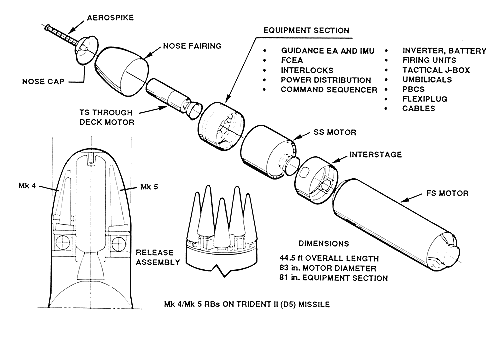
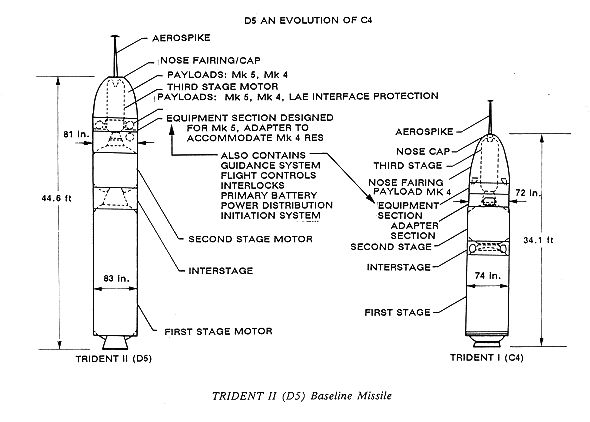
The missile consists of a first stage section, an interstage [IS] section, a second stage section, an Equipment Section [ES], a Nose Fairing [NF] section, and a nose cap section with an aerospike. There is no adapter section like there is on C4. The D5 ES, along with containing all the guidance and electronics, performs the same function as the ES-adapter section in C4 (e.g., structural support between the aft end of the NF and the forward end of the second stage motor).
The first stage and second stage motors are also primary structural components of the missile, connected by an Interstage (IS). Forward of the second stage motor, the adapter section structure of the C4 has been eliminated in D5, and the equipment section (ES) has been extended to serve as the adapter section plus ES. The third stage motor is mounted within and to the ES similar to C4. Structural bracketry on the forward part of the ES is modified from C4, in order to accommodate the bigger Mk 5 reentry vehicle or, with added fixtures, a payload of Mk 4 RBs.
The first stage section includes the first stage rocket motor, TVC system, and the components to initiate first stage ignition. The IS section connects the first stage and second stage sections and contains electrical and ordnance equipment. The second stage section includes the second stage rocket motor, TVC system, and components to initiate second stage ignition.
When compared to C4, for the D5 to achieve the longer range with its larger, heavier payload, improvements in rocket motor performance would be required plus reductions in the weight of the missile's components. To improve rocket motor performance, there was a solid-propellant change. The C4 propellent carried the name of XLDB-70, translated to, cross-link double-base70 percent solid fuels. The solids consisted of HMX (His Majesty's Explosive), aluminum, and ammonium perchlorate. The binder of these solids was Polyglycol Adipate (PGA), Nitrocellulose (NC), Nitroglycerine (NO), and Hexadiisocryanate (HDI). This propellant could have been called PGA/NG, when we consider that D5 propellant is called Polythylene Glycol (PEG)/NG. D5 is called this because the major innovation was the usage of PEG in place of the PGA in the binder. It was still a cross-link, double-base propellant. The use of PEG made the mixture more flexible, more rheologic than the C4 mixture with PGA. Thus, the D5 mixture being more flexible, an increase could be made in the amount of solid fuels; increased to 75 percent solids resulting in improved performance. Thus, D5 propellant's is PEG/NG75. The Joint Venture (the propulsion subcontractors, Hercules and Thiokol) have given a trade name to the propellant NEPE-75.
The motor case material on the D5's first stage and second stage became graphite/epoxy versus the Kevlar epoxy of C4, an inert weight saver. The TS motor was to be Kevlar epoxy but, midway through the development program (1988), it was changed to graphite/epoxy. The change was a range gainer (reduced inert weight) plus eliminated any electrical static potential associated with Kevlar and graphite. There was also a change in all D5 rocket motor nozzles' throat material from segmented rings of pyrolytic graphite in the entrance and throat of the C4 nozzle to a one-piece integral throat and entrance (ITE) of carbon-carbon on D5. This change was for reliability purposes.
The Equipment Section [ES] houses the major guidance and flight control electronics packages. The TS rocket motor and its TVC system are mounted to an eject cylinder at the center of the ES and extends forward of the ES. A small TS eject motor is recessed in a cavity on the TS motor forward dome. When the TS motor is expended, the eject motor pushes the TS motor aft, out of the ES to effect TS separation. The Equipment Section was integrated with the adapter section, using graphite/epoxy versus the aluminum composite structures on C4. This was a weight saver, providing a range gainer. The IS did not change, conventional aluminum. The ES mounting for the third stage rocket motor is similar for both the C4 and D5 with an explosive zip tube used for separation, and the third stage motor has a similar eject rocket motor on the forward end of the rocket motor.
The NF section covers the reentry subsystem components and the forward portion of the TS motor. The NF section consists of a primary structure with provisions for two jettison rocket motors and a locking mechanism. The nose cap assembly at the forward end of the NF houses an extendable aerodynamic spike.
The D5 missile has the capability of carrying either Mk 4 or Mk 5 reentry vehicles as its payload. The D5 reentry subsystem consists of either Mk 4 or Mk 5 reentry vehicle assemblies attached by four captive bolts to their release assembly and mounted on the ES. STAS and pre arming signals are transferred to each reentry vehicle shortly before deployment through the separation sequencer unit. When released, the reentry vehicle follows a ballistic trajectory to the target where detonation occurs in accordance with the fuze option selected by fire control through the preset subsystem.
The reentry vehicle contains an AF&F assembly, a nuclear assembly, and electronics. The AF&F provides a safeguard to prevent detonation of the warhead during storage and inhibits reentry vehicle detonation until all qualifying arming inputs have been received. The nuclear assembly is a Department of Energy (DoE) supplied physics package.
Both C4 and D5 ES PBCSs are similar except C4 had only two simultaneously burning TVC gas generators, whereas D5 has four TVC gas generators. There are two "A" generators which burn initially and provide thrust to the ES, using integrated valve assemblies (IVAs). When the gas pressure drops in the "A" generators due to burnout, the "B" generators are ignited for the remainder of the ES flight.
The post-boost flight of the C4 and D5 ES and reentry vehicle releases are different. With C4, upon completion of the TS rocket motor burn and separation, the PBCS positions the ES, which is maneuvered in space to permit the guidance system to conduct its stellar sightings. Guidance then determines any flight trajectory errors and issues corrections to the ES flight path in preparation for reentry vehicle deployment. The C4 ES then enters a high-thrust mode, the PBCS driving it to the proper position in space and correct velocity for reentry vehicle deployment. During the high-thrust mode, the ES flies "backwards" (RBs face aft to the trajectory). When the correct velocity for reentry vehicle release is obtained, the C4 ES goes into a vernier mode. (ES is adjusted so that the reentry vehicle will be deployed at the proper altitude, velocity, and attitude.)
Upon completion of each reentry vehicle drop, the ES backs off and moves to another position for subsequent reentry drops. During the backing off, gas plumes from the PBCS will impact on reentry vehicles differently, causing reentry vehicle velocity deltas.
In the case of D5, the ES uses its PBCS to maneuver for stellar sighting; this enables the guidance system to update the original inertial guidance as received from the SSBN. The flight control system responding to guidance reorientates the D5 ES and enters a high-thrust mode. However, in the D5 case, the ES flies forward. (RBs are basically down the line of the trajectory.) As in C4, the D5 ES (when it reaches the proper altitude, velocity and attitude) enters the vernier mode to deploy RVs. However, to eliminate the PBCS plume from impacting the reentry vehicle upon release, the ES undergoes a Plume Avoidance Maneuver (PAM). If the reentry vehicle to be released will be disturbed by a PBCS nozzle's plume, that nozzle will be shut off until the reentry vehicle is away from the nozzle's plume area. With a nozzle off, the ES will react to the other three nozzles automatically. This causes the ES to rotate as it backs away from the reentry vehicle just released. In a very short time, the reentry vehicle will be beyond the influence of the plume and the nozzle is returned to normal operation. PAM is used only when a nozzle's plume will disturb the area around an RV. This PAM was one of the design changes to the D5 to provide improved accuracy.
Another design change to help improve accuracy was to the nosetip of the Mk 5 RV. In the TRIDENT I (C4) missile, an error condition existed in some cases upon reentry into the atmosphere when the nosetip ablated at an uneven rate. This caused the reentry vehicle to drift. As the design of the Mk 5 reentry was developed, the change to a shape stable nosetip (SSNT) was established. The nose of the Mk 4 reentry vehicle was boron carbide-coated graphite material. The Mk 5 nose has a metallated center core with carbon/carbon material, forming the rest of the nosetip ("plug"). The metallated center core will ablate at a faster rate than the carbon/carbon parent material on the outer portion of the nosetip. This will result in a blunt, more-symmetrical shape change with less of a tendency to drift and, consequently, a more-accurate and more-reliable system. Prior testing of SSNTs on some C4 missile flights had verified the design concept.
In TRIDENT I (C4), the flight control subsystem converted data signals from the guidance subsystem into steering and valve commands (TVC commands) moderated by missile response rates fed back from the rate gyro package. In TRIDENT II (D5), the rate gyro package was eliminated. The D5 flight control computer receives these missile response rates from the guidance system inertial measuring unit (IMU) as transmitted through the guidance electronic assembly (EA).
The more-extensive use of composites in D5's structure provided inert weight savings. Redesign of ordnance system D5-versus-C4, although functionally the same, in particular the separation ordnance to "cut" structure, contributed to weight savings.
Background Return to Top
The Deputy SECDEF approved a Decision Coordinating Paper (DCP) No. 67 on 14 September 1971 for the ULMS Program, a long-term modernization plan which called for a new, larger submarine and a new, longer-range missile while preserving a nearer-term option to develop an extended-range POSEIDON missile. And in December 1971, the Deputy SECDEF PBD authorized an accelerated ULMS schedule with a projected deployment of the new SSBN and missiles in 1978. In May 1972, the term "TRIDENT" replaced "ULMS," the name "TRIDENT II" was used to designate the ultimate longer-range missile, and the Navy Program Objectives Memorandum (POM) submission outlined funding for the TRIDENT II (D5) program based on a 1984 IOC. Later on 3 August, the SECDEF in a Program Decision Memorandum (PDM) advanced the D5 IOC 2 years to FY 1982. So it beganoscillating D5 IOC dates and associated impacts to the TRIDENT I (C4) development program schedule.
Also on 18 October 1973, a TRIDENT I DSARC (Defense Systems Acquisition Review Council) II and an overall TRIDENT program review was conducted. On 14 March 1974, the Deputy SECDEF issued two requirements. The first requirement was parallel (to C4 development) advanced development effort for major accuracy improvement in the C4 and follow-on missiles (beginning of the IAP). The second requirement was for follow-on alternatives to the C4 missile, or a new D5 missile, or a variant of C4 with larger first stage motor.
The SSPO responded to this second requirement in May 1974 with a brief report grouping candidate missile alternatives into three basic categories: (1) C4 alternatives, 74 in. missiles with varying degrees of C4 commonality; (2) various "stepped" D5 missile alternatives with an 82 in. first stage and 74 in. upper stages that were similar to C4; and (3) D5 alternatives which were all-new, 82 in. missiles.

An abnormal rate of inflation in 1974, plus future increases projected for 1975 - 76, resulted in a SECDEF directed IOC slip of the TRIDENT II to CY 1983. This was followed by a SECDEF decision in January 1975 to a further slip to FY 1985 due to budgetary problems.
On 10 February 1975, the SECDEF issued a study directive for examining feasible degrees of the Air Force's Missile X (MX)-TRIDENT II commonality, potential performance degradations, and resultant cost advantages associated with the various degrees of commonality. It was also during this time frame that the TRIDENT II Characteristics Study was underway. The Navy's perception of the specific military requirement for TRIDENT II were in a state of flux. Hard-target capability appeared to be in the SECDEF's mind but no firm nuclear weapons employment policy appeared. In fact, none was likely until MX commonality and possible improved accuracy alternatives were resolved. In line with this, the SECDEF, on 23 July 1975, deferred TRIDENT II operational availability date (OAD) to 1987.
On 3 May 1976, the Deputy SECDEF wrote to the SECNAV, outlining the desirability of SWS having both survivability and a wide range of capability. The TRIDENT submarine, having invulnerability as well as the potential for increased throwweight, "encourages consideration of options to expand our SLBM capability against the full spectrum of the target system." The Navy was therefore requested to develop an overall TRIDENT II missile development plan for increasing the "utility" of the FBM system for IOC in the 1980s.
In the meantime, in 1976 Congress, for the second consecutive year, denied the Navy's request for research, development, test, and evaluation (RDT&E) funding to initiate TRIDENT II conceptual development.
On 16 August 1976, when the SECNAV responded to the Deputy SECDEF above-mentioned guidance outlining TRIDENT II conceptual goals for an all new D5 hard-target systemhe noted that only minimal in-house effort could be undertaken in FY 1977. But assuming that TRIDENT II funding would be available in FY 1978, it still appeared feasible to plan for a 1987 IOC. Meeting such a schedule, however, would definitely be contingent upon DoD waiver of normal acquisition procedures.
Subequently, trade studies were conducted to define the extent to which the more-expensive elements of the new Trident-II missile would be common with the new Air Force MX ICBM, while unique subsystems could be added to utilize the larger missile sizes usable in the MX weapon system. A TRIDENT II baseline was defined as a point of departure for the study. Although uncorroborated by detailed study, the probable target missile that could be accommodated in the TRIDENT submarine (83 in. diameter and 44 ft length) was established in order to provide maximum performance in the MX application. This baseline TRIDENT II, with a modification to the guidance system, additional electronics hardening, and the addition of an external protective coating for dust and debris protection, was determined to be the common missile. It satisfied the Navy TRIDENT II requirements established for this study but did not satisfy Air Force payload requirements.
The mostly-common missile was a variant to this common missile where, for Air Force application, a unique propulsion stage was used between the common first stage and second stage to configure a longer three-stage missile with increased range/payload performance. It was estimated that 6 to 6 years would be required to develop these missiles after an initial year of detailed program, requirements, and interface definition. The management plan recommended that a single service, either the Air Force or the Navy, should be responsible for development and acquisition of the common or mostly-common missiles. Each service would continue to be responsible for development and acquisition of its unique weapon system elements.
In September 1978, the studies were extended to another variation of commonality wherein two boost propulsion motors would be common for use as TRIDENT II first stage and SS, and as MX first stage and TS. Prospects for the TRIDENT II program were not improved when Congress appropriated only $5 million of the requested $15 million requested for FY 1979. The SECDEF showed a 1990 IOC of the program was funded at a decremented level.
By December 1978, it was the consensus of the Navy, Air Force, and USD&RE that the relatively-small cost advantage (estimated $300 million Navy savings in 1979 dollars) would not offset the risks and disadvantages of a common missile. SSPO internal planning guidance was for a stand-alone TRIDENT II, IOC FY 1990. Thus, the Navy felt free to proceed with TRIDENT II, whatever it might be, and that was the problem.
The Congress felt there was no clearly-delineated requirement for TRIDENT II, and Congressional conferences on appropriations provided only minimal budgets. In addition, the DOD and the Navy positions on types of effort and level of funding fluctuated. In fact, the Navy was instructed in November 1979 to pursue a program of incremental submarine-launched ballistic missile modernization, citing the Presidential decision for full MX development and the difficulty of funding more than one program at a time.
In March 1980, the SECDEF, in his budget submittal to Congress for FY 1981, proposed a significantly-increased level of funding for submarine-launched ballistic missile modernization. The principle emphasis was accuracy improvement applicable to an upgraded C4, a long C4, or an all-new D5 missile which would fill the TRIDENT SSBN launch tube envelope and be capable of increased range, payload, as well as accuracy. A review was to be conducted at the end of FY 1983 to select a modernization option for an IOC not later than CY 1989. As to the issue of affordability, the proposed DoD budget requested $36 million for FY 1981 and reprogramming from other sources of $61 million which would provide $97 million for the first year of ADP.
The House Armed Services Committee (HASC) recommended no funding, but the Senate Armed Services Committee (SASC) recommended a full $97 million. However, the SASC asked for a plan to be provided which incorporates "the fullest possible competition... (and) should consider competing among contractors for each major component, including the integrated missile." If the plan were to reveal that competition of such major components was not in the best interests of the U. S., then a justification should be supplied. Finally, $65 million was appropriated for submarine-launched ballistic missile modernization.
On 6 March 1981, as requested by the SASC, the DoD forwarded the Navy's submarine-launched ballistic missile Modernization Acquisition Plan to the Committees on Armed Services.The letter of transmittal again endorsed an acquisition approach consonant with the evolutionary nature of the submarine-launched ballistic missile program and DoD policy on the issue since 1977. Essential to the plan would be retention of the proven SSPO management structure and the existing Navy/contractor subsystem management teams, with maximum competition at the subcontract level. Since accuracy improvement was a major and challenging objective of the program, use of the existing contractor team was considered the most-efficient approach. The Plan noted that competition at the prime contractor level would result in a duplication of efforts and facilities, a significant increase in program costs, and a delay of the proposed system IOC by approximately 2 years.
On 2 October 1981, President Reagan made an address which called for modernization of the strategic forces. The Defense Department immediately directed the Navy to fund development of the D5 missile with a December 1989 IOC. The planned TRIDENT I missile inventory- would-be reduced from 969 to 630s and all RDT&E effort would be directed toward "a new development, advanced technology, high accuracy D5 system."
Initially, the Navy planned to introduce D5 by backfitting it into the 12th TRIDENT submarine constructed for the C4 system. However, a restructured plan announced on 1 June 1982 introduced the new system with the ninth new construction hull, obviating the need for backfitting four boats, increasing the rate of deployment, and resulting in a cost avoidance of $680 million (FY 1983 dollars).
And in keeping with the objective of effectiveness against the entire target spectrum, Deputy SECDEF Frank Carlucci advised the SECNAV in December 1982 to include funding for a new RV/warhead combination for TRIDENT II. The new reentry vehicle designated Mk 5, was to have a higher yield than the Mk 4, thus increasing the weapon system's effectiveness against hard targets.
Finally, the Deputy SECDEF on 28 October 1983 authorized the Navy to proceed to Full Scale Engipeering Development (FSED) of the TRIDENT II (D5) SWS and initiate production to meet a December 1989 IOC. Thus, the third and final phase of the Navy's ULMS program long-term modernization plan was underway.
The D5 Development Flight Test Program originally consisted of 20 D5X missile flat pad flights and 10 PEM flights from a TRIDENT SSBN. Flight testing began in January 1987 and in 1988. The program was reduced to 19 D5Xs and 9 PEMs.
The flight test program of the missile and the guidance subsystems of the weapon system began in January 1987, and the overall performance results from the tests indicated that the missile was achieving its objectives for this phase of the program. Of the 15 tests conducted as of September 30, 1988, 11 were successful, 1 was partially successful, 2 were failures, and one was a "no-test" [the 15th flight test was destroyed by command destruct early in its flight while the missile was performing normally at the time the decision was made to destruct: therefore, the flight was a "no-test"]. Although the majority of the tests were successful, each of the failures involved different problems and occurred at different stages of the missile flight.
A problem encountered during the seventh flight requires a redesign of the Post Boost Control System. During the deployment phase of the seventh flight, one of the valves in the system, which controls the flow of hot gases through the system, remained closed and limited the system's steering capability. Engineering evaluations indicate there was overheating or contamination in the valve, causing it to stay closed. The redesign was incorporated during the 1989 testing program.
During the ninth flight test, the missile lost control and went off course about 14 seconds into third stage flight and self-destructed. Engineering verification of the failure indicated that a short in one of the power supplies, which control the flight control computer, prevented the computer from providing the proper steering commands for the missile's third stage. The problem was solved through minor changes in the flight control computer. Also, there has been no reoccurrence of the problem in subsequent flight tests.
During the 13th flight, the missile encountered a problem with the thrust vector control subsystem on its first stage, causing it to lose control and go off course about 55 seconds into flight.) The missile was destroyed by the range safety officer for safety reasons.
During the 15th flight, the missile was destroyed by command destruct early in its flight. The missile wars performing normally at the time the decision was made to destruct, thus resulting in a no test. A combination of events prompted the destruct action, including the specific trajectory selected to be flown, the prelaunch weather conditions, and the missile dynamics along the flight path, which resulted in the missile looking to the range safety officer as though itwould cross the boundaries of the safety corridor.
Recent Developments Return to Top
USS LOUISIANA (SSBN 743), the last of the 18 Trident submarines to be constructed, successfully launched one unarmed Trident II (D-5) ballistic Missile on 18 December 1997. The launch from the submerged submarine took place on the United States' Eastern Range, off the coast of Florida, as part of LOUISIANA's Demonstration and Shakedown Operation (DASO). The purpose of the DASO is to demonstrate the submarine crew's ability to meet the stringent safety requirements for handling, maintaining and operating the strategic weapons system. The DASO also confirms the submarine's ability to correctly target and launch a Trident missile. This was the 77th consecutive successful launch of the Trident II (D-5) missile since 1989; the longest string of successes in the history of United States' ballistic missiles
The US Navy's Trident II Submarine-Launched Ballistic Missile system routinely conducts joint DOE/Department of Defense flight tests on instrumented Mk5 Reentry Bodies known as Joint Test Assemblies (JTAs). During a past flight, the JTA telemetry experienced a single-event upset occurrence as it flew through the Van Allen Belt and the South Atlantic Anomaly (an intense, low-altitude high-energy proton belt). A multidisciplinary effort by Sandia Lab scientists and engineers assembled to determine the causal elements and to assist in devising a solution. To correct for this event, the W88-0/JTA telemetry system was redesigned by incorporating into the signal processor design four high-energy-proton-resistant integrated circuits.
Specifications Return to Top |
|
| Primary Function: | Strategic Nuclear Deterrence |
| Contractor: | Lockheed Missiles and Space Co., Inc., Sunnyvale, Calif. |
| Unit Cost: | $29.1 million (current production) |
| Power Plant: | Three-stage solid-propellant rocket |
| Length: | 44 feet (13.41 meters) |
| Weight: | 130,000 pounds (58,500 kg) |
| Diameter: | 74 inches (1.85 meters) |
| Range: | Greater than 4,000 nautical miles (4,600 statute miles, or 7,360 km) |
| Guidance System: | Inertial |
| Warheads: | Thermonuclear MIRV (Multiple Independently Targetable re-entry Vehicle); Maneuverable Re-entry Vehicle |
| Date Deployed: | 1990 |
Images Return to Top
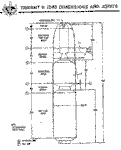
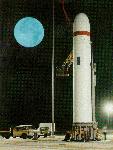

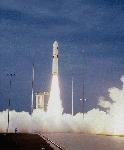
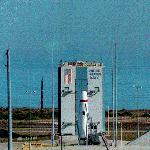
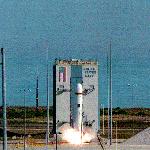
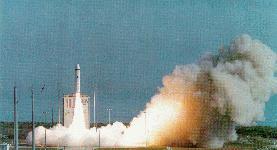
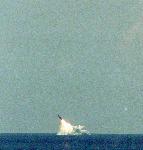
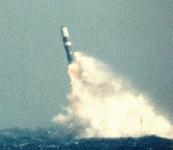
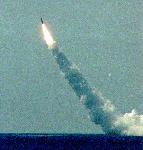
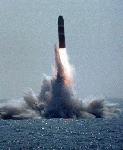
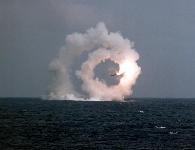
Sources and Resources Return to Top
- "A History of the FBM System" by Lockheed Missiles and Space Company, Inc.
- BUMPERS AMENDMENT NO. 2398 -- DEPARTMENT OF DEFENSE APPROPRIATIONS ACT, 1996 (Senate - August 11, 1995)
- AMENDMENT NO. 6 OFFERED BY MR. LUTHER - TERMINATION OF NEW PRODUCTION OF TRIDENT II (D-5) MISSILES - NATIONAL DEFENSE AUTHORIZATION ACT FOR FISCAL YEAR 1998 (House of Representatives - June 20, 1997)

